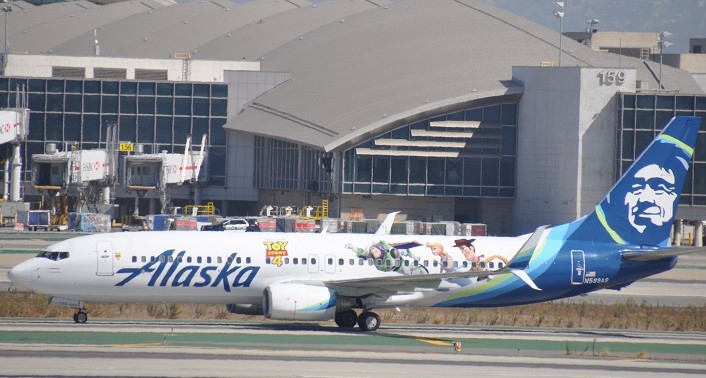Ever since 2005, Alaska Airlines’ Boeing 737s have sported stickers underneath their cockpit windows stating: “Proudly All Boeing.”
That has no longer been true since Alaska bought Virgin America in late 2016, but the stickers remained anyway.
Alaska inherited an all-Airbus fleet from Virgin America, a brand that has since disappeared, comprising 61 older Airbus A319s and A320s plus ten new A321neos are currently flying in the new Alaska livery.
READ: Boeing’s 777X test program accelerates.
The big question now is: What is next?
Alaska is slated to join the oneworld airline alliance by mid-2021 and has announced it will use this as a step to grow aggressively, also trying to keep main competitor Delta in check.
Alaska had ordered 37 Boeing 737 MAX 9s in 2012, “but we have been lucky as we didn’t have any of them in our fleet yet when it was grounded,” says Alaska chief executive Brad Tilden in an interview with AirlineRatings.
Now the race is on for the next big order from Alaska, reportedly for up to 200 aircraft. Half of these will be replacements, most urgently of the older Airbuses, the other half for growth.
Normally, ordering another big batch of MAX 9s, and probably 10s, would be almost a given.
But these are not normal times in Seattle and that brings the A321neo on the table as possible aircraft to order.
That aircraft or even A321LRs or XLRs would absolutely make sense, given the neo is already part of the current fleet.

But is it even conceivable that Boeing’s hometown airline and so far fiercely loyal customer would go out and defect to Airbus, at least partially?
Tilden doesn’t answer this question directly and could be expected to say “no” if he did.
Instead, he explains: “We are very fortunate, Boeing has treated us really well.”
He goes on to outline just how close both companies are, both physically and mentally:
“For our Boeing aircraft deliveries, the flight is about four miles from the delivery center at Boeing Field to our base at Sea-Tac Airport,’’ he says.
“There are all sorts of connections in Seattle, many families have members working at both companies, they are very closely intertwined.”
He adds a vague: “We will see where the future goes.”
The Seattle Times recently reported on internal company messages from management to Alaska staff stating that, also due to the MAX crisis, some Airbus aircraft will stay in the fleet at least as long as 2025.
That is a given for the newest A321neos, which are currently deployed on lucrative transcontinental routes.
While Alaska’s focus these days is on runs up and down the US West coast, the airline serves East-West routes between destinations from Hawaii in the West to New York in the East.
It is still hugely important for connecting communities in the north with often no other infrastructure available but Tilden notes: “Our actual flying in Alaska is now only about 13 percent of our business.”
A clear focus on growth, especially with Alaska due to join oneworld, will mean ever closer cooperation with American, which will use Alaska’s domestic feed in Seattle to start new long-haul routes, including to Bangalore, India.
The Seattle Times also reported on an internal memo from Alaska’s vice president flight operations to pilots about a potentially much wider scope.
“Although doing our own widebody international flying is not part of our strategic plan today, this relationship doesn’t preclude us from exploring it in the long term,” he said.
He called the alliance “the first step toward international long-haul becoming a viable option for us.”

Tilden shares the enthusiasm about joining the alliance, noting: “The benefits are huge and we are super excited about a closer relation with American Airlines and joining oneworld.”
But he is also aware of the new challenges this brings, especially as the Alaska Airlines brand, sporting the Eskimo as a tail logo since 1972, is not known well outside the US West Coast and not a household name everywhere in that market.
“I agree there is a challenge to explain to, say a Chinese traveler, who we are when he wonders whether he should travel on us from Los Angeles to Hawaii,’’ Tilden notes
“But we even have this challenge today to some extent in California already.
“In Alaska, Washington and Oregon people know us really well. In California, this is a bit of an issue and we are working on it. But joining oneworld is a paradigm shift for us.”
At least the last huge challenge for Alaska, managing the merger with Virgin America, is well in hand after three years.
“Mergers are very, very hard,’’ Tilden admits. “We thought they were hard, but we learned as we did it they are even harder than we thought.
“I think our people did an exceptional job and our merger did get done (at) a more rapid pace than a lot of other mergers.”
The Alaska CEO concedes that some things remain to be done and that there have been cultural differences arising from the merger for both passengers and staff.
This was especially true in the San Francisco Bay Area, where Virgin America was deeply rooted and the airline’s distinct culture very much liked.
It has sometimes been a tough sell for Alaska especially given that post-merger, the airline installed new cabins with less seat pitch than Virgin America used to offer.
“The hardest thing with mergers is merging the two cultures,’’ Tilden says. “I would give us a grade ‘C’ on it. It is in progress, I think we underestimated how difficult it’s going to be.
“I am very optimistic that we are gaining momentum on it now and it will end up being an ‘A’ grade. But it’s a hard thing to accomplish and we are still working on it.
“The systems, the technology, processes, procedures, contracts, airplanes, that’s all 99 percent done. I would say that cultural work is 50 percent done.”
























